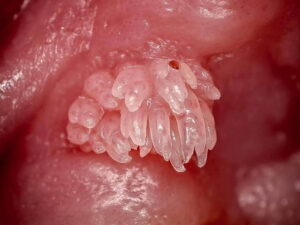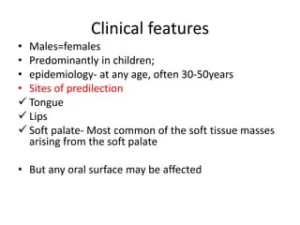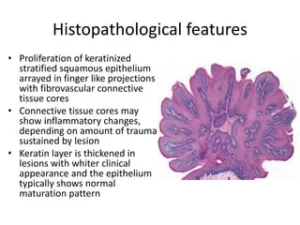Squamous Papilloma

The oral squamous papillomas are seemed to be associated with papilloma viruses, the one commonly incriminated as causative in skin warts. It is the fourth most common oral mucosal mass and is found in four of every 1,000 and accounts for 3-4 percent of all biopsied oral soft tissue lesions.
The HPV types 6 and 11, commonly associated with squamous papillomas, failed to be demonstrated in oral malignancies as well as potentially malignant oral lesions. Even though all HPV lesions are infective, the squamous papilloma appears to have an extremely low virulence and infectivity rate; it does not seem to be contagious.
Since the squamous papilloma may be clinically and microscopically indistinguishable from verruca vulgaris, the virusinduced focal papillary hyperplasia of the epidermis, it is briefly discussed in this section.
Clinical Features

The papilloma is an exophytic growth made up of numerous, small fingerlike projections which result in a lesion with a roughened, verrucous or ‘cauliflowerlike’ surface. It is nearly always a well circumscribed pedunculated tumor, occasionally sessile. It is painless, usually white but sometimes pink in colure. Intraorally it is found most commonly on the tongue, lips, buccal mucosa, gingiva and palate, particularly that area adjacent to the uvula. The majority of papilloma’s are only a few millimeters in diameter, but lesions may be encountered which measure several centimeters. These growths occur at any age and are seen even in young children. A series of 110 cases has been reported by Greer and Goldman, while a series of 464 cases has been studied by Abbey and his coworkers; this is some- what indicative of the prevalent nature of the lesion.
The common wart or verruca vulgaris, is a frequent tumor of the skin analogous to the oral papilloma. It is uncommon on oral mucous membranes but extremely common on the skin. The associated viruses in verruca are the subtypes HPV-2, HPV-4 and HPV-40. Clinically it shows pointed or verruciform surface projections, a very narrow stalk, appears white due to considerable surface keratin, and presents as multiple or clustered individual lesions. It enlarges rapidly to its maximum size, seldom achieving more than 5 mm in greatest diameter. Verruca vulgaris is contagious and capable of spread to other parts of an affected person’s skin or membranes by way of autoinoculation. Lesions that are histologically identical to the verruca vulgaris of the skin are frequently found on the lips and occasionally intraorally . These are often seen in patients with verrucae on the hands or fingers, and the oral lesions appear to arise through autoinoculation by finger sucking or fingernail biting.
Papillomalike or papillomatous lesions as well as ‘pebbly’ lesions and fibromas of various sites in the oral cavity are recognized as one of the many manifestations of the multiple hamartoma and neoplasia syndrome (Cowden’s syndrome). This is an autosomal dominant disease characterized by facial trichilemmomas associated with the gastrointestinal tract, the thyroid, CNS and musculoskeletal abnormalities as well as oral lesions. It is also considered a cutaneous marker of breast cancer.
Histologic Features

The microscopic appearance of the papilloma is characteristic and consists of many long, thin, finger-like projections extending above the surface of the mucosa, each made up of a continuous layer of stratified squamous epithelium and containing a thin, central connective tissue core which supports the nutrient blood vessels . Some papilloma’s exhibit hyperkeratosis, although this finding is probably secondary to the location of the lesion and the amount of trauma or frictional irritation to which it has been subjected. The essential feature is a proliferation of the spinous cells in a papillary pattern; the connective tissue present is supportive stroma only and is not considered a part of the neoplastic element. Occasional papilloma’s demonstrate pronounced basilar hyperplasia and mild mitotic activity which should not be mistaken for mild epithelial dysplasia. Koilocytes (HPV altered epithelial cells with perinuclear clear spaces and nuclear pyknosis) may or may not be found in the superficial layers of the epithelium. The presence of chronic inflammatory cells may be variably noted in the connective tissue.
Treatment and Prognosis
Treatment of the papilloma consists of excision, including the base of the mucosa into which the pedicle or stalk inserts. Removal should never be accomplished by an incision through the pedicle. If the tumor is properly excised, recurrence is rare. The possibility of malignant degeneration in the oral papilloma is quite unlikely, although fixation of the base or induration of the deeper tissues should always be viewed with some suspicion.
Intraoral verruca vulgaris is also treated effectively by conservative surgical excision or curettage, but liquid nitrogen cryotherapy and topical application of keratinolytic agents (usually containing salicylic acid and lactic acid) are also effective. Recurrence is seen in a small proportion of treated cases.